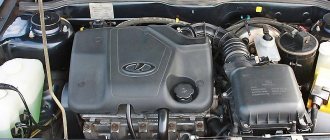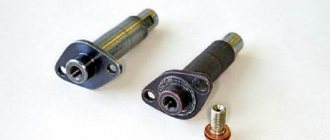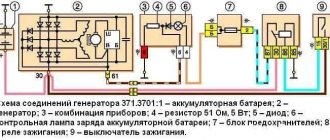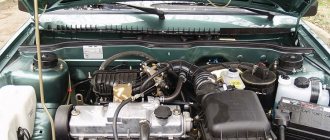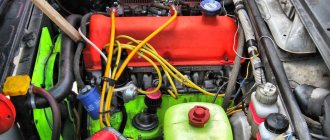- Engines
- Peugeot
- XUD9SD
The 1.9-liter diesel engine of the Peugeot XUD 9 SD or DHW was produced from 1995 to 2007 and was installed both on models of the French concern and on cars from other manufacturers. This motor is well known in our automotive market due to its installation on the Niva.
- Characteristics
- Consumption
- Application
- Breakdowns
Technical characteristics of the Peugeot XUD9SD 1.9 TD engine
| Exact volume | 1905 cm³ |
| Supply system | prechamber |
| Engine power | 63 – 75 hp |
| Torque | 130 – 140 Nm |
| Cylinder block | cast iron R4 |
| Block head | aluminum 8v |
| Cylinder diameter | 83 mm |
| Piston stroke | 88 mm |
| Compression ratio | 21.5 – 22.0 |
| Features of internal combustion engines | No |
| Hydraulic compensators | No |
| Timing drive | belt |
| Phase regulator | No |
| Turbocharging | Yes |
| What kind of oil to pour | 4.5 liters 5W-40 |
| Fuel type | diesel |
| Environmental class | EURO 1/2 |
| Approximate resource | 450,000 km |
Materials about the diesel Niva were once published by the magazine Behind the Wheel
MANUAL
Many manuals for engines of the line have been collected on the Citroen club forum
ARTICLE
Most common engine faults are described in this article.
XUD9A
The XUD9A engine was one of the first modifications in the XUD9 engine line. This motor model was first installed in 1987. The advantages of the unit are its high reliability and endurance. The model has good maintainability and can travel 400-500 thousand kilometers without complex and expensive repairs. The manufacturer took into account some of the shortcomings of the previous model and eliminated them, making the engine of higher quality. However, some disadvantages remained unchanged, for example, the expensive adjustment of valve clearances every hundred thousand kilometers, the fragility of the fuel filter cup and its mandatory timely replacement. The engine is filled with 5.5 liters of semi-synthetic oil 10w40.
Main characteristics of the Peugeot XUD9A engine:
| Engine capacity in cubic centimeters | 1905 |
| Timing drive type | SOHC/OHC |
| Maximum horsepower | 68-70 |
| Stroke/Bore in millimeters | 88/83 |
| Fuel/Consumption liters per hundred kilometers | Diesel/7.4-8.3 |
| Compression ratio | 22,5-23:1 |
| Maximum torque at rpm | 120/2000 |
| Engine Features | Location R4, in-line, cooling system - water, four cylinders, five main bearings, timing belt, camshaft drive, two valves per cylinder |
| Maximum horsepower at rpm | 68-70/4600 |
| Supply system | Diesel direct injection |
The French automaker supplied engines to the following models:
- 306 sedans and hatchbacks from 1993 to 1997;
- 405 sedans from 1987 to 1993.
This engine was also used by CITROEN (on the ZX Estate/Break/ZX, Relay, Jumpy, Jumper, Dispatch, C 25, BX Break/BX models) and FIAT (on the Ducato, Scudo and Scudo Nato models).
Disadvantages, breakdowns and problems of the Peugeot XUD 9SD
The main problem of the engine is the low location of the expansion tank
As a result, a lack of coolant leads to a breakdown of the cylinder head gasket.
If you do not follow the instructions for replacing the fuel filter, the injection pump will fail.
The fuel filter glass often breaks when replacing it, but it is not cheap
Approximately once every 100,000 km, the thermal valve clearances have to be adjusted here
Using cheap oil quickly affects the condition of the engine turbine
The network describes cases of prechambers falling out of the cylinders at very high mileage
You can contact the site administrator by email: [email protected]
All texts were written by me, are authored by Google, included in the original Yandex texts and notarized. For any borrowing, we immediately write an official letter on company letterhead in support of search networks, your hosting and domain registrar.
Next we go to court. Don’t try your luck, we have more than thirty successful Internet projects and have already won a dozen lawsuits.
HOW NIVA BECAME A TRACTOR
VARIATIONS ON THE THEME
HOW NIVA BECAME A TRACTOR
The dream of a passenger car with a diesel engine has long lived in our car enthusiasts. And now it is becoming a reality: diesel Nivas and Ladas have gone on sale.
Sergey MISHIN. Photo by the author
VAZ made its first attempt to satisfy the aspirations of the then Soviet people in 1988. The VAZ 21055, equipped with a 1.45-liter diesel engine of its own production, passed state tests and was recommended for mass production, which never began.
Since then, diesel has grown in volume and increased in power and torque. Although the index remained the same - VAZ-341. Today it is manufactured in Barnaul and installed on the “four” (21045), turning the station wagon into a real workhorse.
But such an engine is suitable not only for a delivery vehicle: it is simply created for an all-terrain vehicle! True, for the all-wheel drive transmission of the Niva, the 341st turned out to be rather weak - we had to add turbocharging and one digit to the diesel index - it turned out to be 3411. The Niva with such an engine is designated VAZ 21215-50. But on September 9, 1998, the Niva VAZ 21215–10 with the Peugeot XUD-9SD engine rolled off the assembly line. This is exactly what visitors to the Paris Motor Show could see. This diesel engine, which meets modern toxicity standards with exhaust gas recirculation and a converter, should help re-tread the overgrown export path to Europe.
However, back in 1993, one of the Niva versions for export was equipped with a Peugeot-XUD-9L diesel engine. A semi-finished product with a “technological” gasoline engine rolled off the assembly line in Togliatti - and only in Chekhov near Moscow at the Lada-Export enterprise did it turn into a diesel car. It all ended with the introduction of Euro II standards in Western Europe, which the XUD-9L did not meet. Now cooperation is about to resume at a new level.
Without waiting for this to happen, we drove a prototype. For comparison, we took, naturally, domestic diesel.
The engines start in the same way and not quite as usual. Having turned on the ignition, you need to wait until the glow plug indicator light goes out and only then turn the key to “Start”. Literally from the first revolution, the motors come to life, producing a characteristic tapping sound. The Frenchman can be spurred on immediately after launch. The empty car starts off willingly from second gear. As the engine warms up, it runs softer, but no increase in traction is felt. The turbine didn’t show itself in this sense either—they didn’t even notice when it turned on. It turns out that this is as it should be, since its main task is to reduce toxicity. There is no need to put pressure on the gas, as in a gasoline car - the jeep accelerates easily at low speeds, so much so that you can easily switch from third gear straight to fifth. It is the main one here, both when driving around the city and on the highway. On the highway, the car hardly notices hills and headwinds, it easily accelerates when overtaking, without requiring an extra shift. The noise of the Niva remained at the usual level, as it is determined by the howl of the transfer case, drowning out the roar of the French engine.
Domestic diesel engines operate noisier and harsher, not wanting to take on the load when cold. And after warming up, you have to drive it more persistently. The turbine is to blame for this: it turns on only above 2200–2500 rpm and only then provides dynamic acceleration. When driving actively, you need to change gears even more often than in a gasoline car. The only consolation is the gain in dynamics compared to the “French” with a larger volume.
What are all-terrain vehicles like for off-road use? From the first meters, the Peugeot was upsetting. excess traction at low speeds. The slightest carelessness - and the car tried to stall. Obviously, the popular Nivovsky VLi-10 tires with a universal tread are to blame for this (possibly also the gear ratios in the transmission). If you replace the tires with something toothier, the minus will immediately change to a plus.
Why did it happen so?
Perhaps the automatic requests do not belong to you, but to another user accessing the network from the same IP address as you. You need to enter the characters into the form once, after which we will remember you and be able to distinguish you from other users exiting from this IP. In this case, the page with the captcha will not bother you for quite a long time.
You may have add-ons installed in your browser that can make automatic search requests. In this case, we recommend that you disable them.
It is also possible that your computer is infected with a virus program that is using it to collect information. Maybe you should check your system for viruses.
If you have any problems or would like our support team, please use the feedback form.
Diesel for Niva: solving problems of self-installation
Passenger cars and SUVs with diesel engines are very popular abroad. For us, the idea of equipping a car with such an engine did not take root for a long time. Only recently UAZ SUVs with such an engine began to arrive on the automobile market.
And yet there have been attempts to make an SUV with a diesel engine. One example of such a car was the diesel Niva. This VAZ Niva 2121 model was exported and had an index of 21215.
Equipping a car with a diesel unit has a number of positive qualities. These engines are significantly more economical than gasoline-powered units and are less demanding on fuel quality. They have good traction performance at low engine speeds. The diesel engine has a longer service life, which allows it to be used longer without major repairs.
The main disadvantage of these engines is the complexity and high cost of repairing the fuel system, since a number of units use parts with high precision processing.
Features of operation
To ensure long-term and trouble-free operation of the power unit, it must be very carefully and properly maintained. It is also recommended not to allow the engine to operate in extreme modes.
First, let's look at the VAZ-2123 engine, it is a modified version of the power unit installed on the “classic Niva”. The main differences are as follows.
- There are additional fasteners for installing additional equipment.
- The oil filter is not screwed directly into the block, which was typical for all VAZ engines, but has an intermediate insert. This insert is called the oil pump bracket. The power steering pump is also attached to it.
- The cylinder head has been slightly modified. It is designed for the use of INA hydraulic supports.
- A new pump was used, it is marked 2123. The main difference is the use of a roller bearing instead of a ball bearing.
- The pan has been modified; the front axle gearbox is no longer attached to it.
- The fuel rail used is 2123-1144010-11.
The Z18XE engine was widely used in various car models. There are several modifications of the power unit. Installed on the Chevrolet Niva, it had the following features.
- Electronic throttle. This made it possible to more effectively manage the fuel supply.
- Two lambda probes were built into the new intake manifold.
The result was an original motor with interesting settings. Thanks to the settings, it is possible to achieve some variation in power and throttle response.
Factory Niva with a diesel unit
Initially, the developers attempted to install 2121 domestically produced diesel engines on the Niva. This diesel engine had a combustion chamber volume of 1.5 liters and was turbocharged. But the idea of a domestic diesel engine for the Niva failed. The reason for this was its low power. Niva 2121 with this engine was not capable of efficiently covering off-road conditions.
There were attempts to install domestic diesel engines on the Niva, the volume of which was increased to 1.08.9 liters. Moreover, they were installed on the Niva 2121 in both 3-door and 5-door bodies. But these were experimental models that never made it into mass production.
The way out of the situation was to install a foreign-made model. As a diesel engine, the Niva began to be equipped with a Peugeot engine with the factory index XUD-9SD. It was quite common and was installed on many cars.
Diesel engine
The main advantage of this diesel engine was excellent traction at low speeds, which allowed the car to easily overcome off-road conditions and dirt. At the same time, the Peugeot diesel unit was reliable and had good maintainability.
The maximum speed for the Niva 2121 with a Peugeot engine was set at 120 km/h. But the dynamics during acceleration were not up to par. The speedometer showed a speed of 100 km/h only after 25 seconds. But this indicator is not so important, since for the Niva 2121 high cross-country ability is much more important than speed characteristics.
Niva 2121, on which a diesel unit from Peugeot was installed, was produced until 2009, after which its production ceased. Since the Niva diesel was an export option, it is rarely seen here. Those cars that can be seen on our roads are most often re-exported.
Malfunctions
Quite often, drivers complain about the quality and reliability of the Chevrolet Niva internal combustion engine. In fact, there are quite a few problems here, and first of all we are talking about technical shortcomings. It was previously mentioned that drivers may experience a broken belt on the Z18XE, and in this case, there will be bent valves. This clearly leads to the need for major repairs.
The timing chain drive, which is equipped with the domestic power unit, can also create problems. There is a hydraulic tensioner installed there; it can fail already at a mileage of 50 thousand. If you do not pay attention to this in a timely manner, the chain jumps. Accordingly, we get damaged valves.
Also on the VAZ-2123, hydraulic compensators may fail. This leads to valve knocking and increased fuel consumption. Another standard problem for Russian engines is constant leaks. Oil can escape from under any gaskets, which is not very good.
Both engines have a common problem with the ignition modules. They often fail at a mileage of 100-120 thousand. The first sign of a breakdown can be called engine tripping.
The Z18XE engine is characterized by a failure of the control unit. Often in this case a number of problems arise in the operation of the motor. Moreover, the ECU may generate errors from different sensors, and they will change after each reset. Inexperienced mechanics often go through the entire engine until they get to the true cause of the breakdown. Floating speeds may also occur, especially at low speeds, the reason is contamination of the throttle valve.
Also interesting: Hyundai introduces a new generation of Tucson with best-in-class features
Self-installation of a Peugeot engine
There are also Nivas on which the owners install diesel engines themselves, or they turn to specialized service stations that replace engines.
This diesel engine is the easiest to install on a car, since the mounting points on the XUD-9SD are exactly the same as on the original gasoline engine. It is worth considering that in addition to replacing the engine itself, some modifications have to be made. There is also the possibility of installing the XUD 11 power unit, produced by the same Peugeot, on the Niva instead of the XUD-9SD.
In addition to the engine itself, the gearbox will also need to be changed. This is due to the fact that the original VAZ gearbox will not be able to withstand the loads that the diesel unit will create on it. Instead of a VAZ gearbox, a Fiat Polonaise gearbox is often installed. It is used because the same XUD-9SD unit was installed on the Polonaise. The clutch housing is also installed together with the gearbox.
In addition, owners who convert the Niva to the XUD-9SD diesel engine also additionally change the front mounting supports of the unit. The pallet also undergoes transformations. The exhaust system will also need to be redone. To ensure additional reliability of front-wheel drive elements, some parts are replaced with similar ones from Chevrolet Niva.
To ensure proper cooling of the power plant, the standard radiator is often replaced with a radiator from a Gazelle. At the same time, the rubber pipes are also changed. It wouldn't hurt to install a diesel fuel heating system in winter.
After all these alterations and modifications, documentation will be required at the State Traffic Inspectorate.
VAZ 21214 engine modifications and their differences
| Motor modification | Availability of power steering | An exhaust manifold | EURO environmental class |
| 21214-41 | welded from stainless steel become | 3 | |
| 21214-34 | _ | cast iron | |
| 21214-33 | |||
| 21214-32* | |||
| 21214-31 | welded from stainless steel become | 4 | |
| 21214-30 | — |
*21214-32 – has fuel pipes with quick connectors, a flywheel for the clutch of 215 mm (200 mm on other models).
The geometry of the cylinder block 21214 and 21213 is the same. There are no liners in the cylinders. Due to the use of an ejector, the configuration of the front engine cover has been changed to accommodate the installation of a crankshaft position sensor. To mount the power steering, a hole is made on the block for installing a bracket; in addition, there is a threaded hole for installing a knock sensor, as well as threaded holes with studs for mounting the ignition module bracket.
The ShPG came from 21213. Crankshaft 21213-1005015 sets the piston stroke to 80mm. The crankshaft pulley is distinguished by the presence of teeth along the outer diameter for the operation of the crankshaft position sensor. The latest internal combustion engine models are equipped with a damping pulley (21214-1005058-10).
Cylinder head 21214-1003011-30 (36) was modified from the head from 21213. For modification, it was necessary to introduce holes for installing a phase sensor and studs for mounting the intake receiver. To install hydraulic compensators, bosses are cast in the head and have threaded holes in them. With the introduction of hydraulic thermal gap compensators, adjusting bolts were eliminated from the head design.
Oil under pressure is supplied to the hydraulic compensators through separate pipes. There are two types of heads: Russian 21214-1003015 and Canadian 21214-1003015-30. The differences between the heads are as follows: in the first, the diameter of the threads in the holes for hydraulic compensators is M18/1.5, the wells for hydraulic compensators do not have drainage holes;
the second ones have M24x1.5 holes, and the wells have drainage holes (the markings are made in the casting). Interchangeability of heads, as well as hydraulic supports of old and new designs, is not possible. A new oil rail 21214-1007180-30 made of stainless steel is used, supplying oil to the hydraulic compensators. Interchangeability with ramp 21214-1007180 is maintained.
Also interesting: Niva-Chevrolet with an Opel engine: brief description, technical characteristics, owner reviews
Valve levers 21214-1007116-30, in contrast to the previous 2101-1007116, have a smaller radius (11 mm) of the platform support interacting with the camshaft cam, as well as an additional groove on the side of the hydraulic compensator. Both lever options are interchangeable.
In the timing camshaft drive, instead of a double-row chain, a single-row chain 21214-1006040-03 is used on rollers and bushings. Single-row sprockets for the chain are taken from the 2123 engine. The oil pump sprocket has the number of teeth reduced to 30 to increase the performance of the oil pump and improve the operation of the hydraulic chain tensioner and hydraulic compensators.
The camshaft 21214-1006010 is original with a modified cam profile and can be interchanged with the shaft from 21213.
The 80 amp generator is the same as the 2112, with a slight difference in the diameter of the pulley 80 mm for the drive belt 2107-1308020 (944 mm).
The exhaust manifold can be made of cast iron or stainless steel. The cast iron manifold is made by casting. The stainless steel manifold version has a welded design. A welded manifold is lighter and heats up quickly, which is good for the operation of the catalyst located in the manifold. In addition, an oxygen sensor is installed in the exhaust manifold.
The intake manifold and fuel rail (2123-1144010-11) were borrowed from the 2123 engine. The injectors of the fuel injection system are SIEMENS VAZ 20734 (yellow), injectors (0280 158 110) were installed on early engines.
Ignition module from engine 2112.
Electronic control is carried out by the BOSCH MP 7.9.7 ECU. or JANUARY 7.2 depending on the year of manufacture and modification of the internal combustion engine.
The cooling system began to be assembled using gaskets with an elastic polymer bead, which improved the tightness of the system. The water pump (pump) includes an oil seal (cuff) that is more resistant to wear and loss of properties.
Which engine is suitable for a Niva from a foreign car without modifications?
To improve the performance of your car, you can install a Niva engine from a foreign car without modifications. The VAZ-2121 has long been considered one of the best domestic cars both in terms of engine power and driving performance. But now this car model has become outdated, and many motorists are trying to somehow improve it. What engine should be installed as an analogue to the 1.7 liter petrol injection engine?
Replacement problem
The fact is that to replace the engine on a VAZ-2121, you can choose almost a dozen different engines, but they are all from foreign cars. But the main problem is that you will have to do some additional work during installation, for example, install or change fasteners, add new parts. Because of this, it is not so easy to find a budget replacement option. The choice is significantly narrowed down to just a few options. For an engine to be suitable for installation, it must meet several conditions:
Which engine should you consider first?
Improved Niva
The injector installed on the Niva, although it reduces fuel consumption, is still not the most economical option in urban conditions with traffic jams and other delays. On the highway and during long trips outside the city, this is not felt so much, since the car works without stops and downtime. Due to the unprofitability of cars in urban environments, drivers are thinking about a good and effective replacement for the old injection-type engine in their car. The best option would be a diesel engine for the Niva. It has approximately the same power characteristics, but its fuel consumption is comparatively lower. Also, diesel is less capricious in terms of fuel quality. What options from this category of motors are worth detailed consideration?
In fact, this is the only option that suits all parameters.
Conclusion
Diesel engines NIVA or XUD9SD are reliable, but have a short mileage before major repairs. Although, on the other hand, carrying out overhauls of power units is quite difficult.
Niva is an off-road vehicle. We know that the capabilities of an SUV depend on a number of factors, which together give the vehicle good cross-country ability. One of them is the characteristics of the power unit. Let's look at the features of the Niva with a diesel engine.
Modified options
Since it is not always possible to supply an engine of a certain foreign car, it is worth considering imported production options that require a little modification:
- The first candidate will again be the French engine from Peugeot XUD 11 series. Since the power of this unit is higher than that of the previous model, some changes will need to be made to the design of the Niva - replacing the gearbox. An acceptable option is a gearbox from Fiat Polonez. In addition, a good solution would be to replace the front supports of the power plant fasteners, pan and exhaust system. It is also worth replacing the drive elements with similar parts from the Chevrolet Niva.
XUD9TE
The turbocharged XUD9TE was presented in three modifications - D8B, DHX and /Y(DHY). The engine was produced from 1992 to 2000 and was used in minibuses, commercial and passenger cars of several French manufacturers and one Italian.
| Engine capacity in cubic centimeters | 1905 |
| Engine Features | Charge intercooling, timing belt drive, water cooling system, four cylinders, five main bearings, timing belt, two valves per cylinder |
| Timing drive type | SOHC/OHC |
| Fuel/consumption in liters per hundred kilometers | Diesel/ |
| Horsepower | 92-92 |
| Piston stroke/Cylinder diameter in millimeters | 88/83 |
| Supply system | Prechamber |
| Supply system | Diesel direct injection |
| Block head/cylinder block | 8v aluminum/R4 cast iron |
| Compression ratio | 21,8:1 |
| Turbocharging | Turbine KKK |
| Power D8B/DHX/Y(DHY) | 66 kW (90 HP)/66-68 kW (90-92 HP)/66-68 kW (90-92 HP) |
NIVA Diesel with Peugeot engine
A Niva with a diesel engine is no longer a dream - it’s a reality. You can touch it with your hands and take a picture. You can even ride it if you're lucky.
PSM has long and successfully offered everyone “a wide range of diesel, gasoline, and liquefied gas engines with power from 20 to 200 hp.” The Volzhsky Automobile Plant has long been looking for a diesel engine that would fit perfectly into a VAZ car. And although PSM’s proposal was not the only one. The choice fell on this company. Why? We asked Vladimir Trofimov, deputy technical director of the Lada-Export joint-stock company, to answer this question - a company created, according to him, to work out all modifications of the VAZ car that the market requires, but cannot be made on the Volzhsky Automobile Plant's production line.
The choice of PSM engines is not at all accidental. This company is well known and reputable. It is a branch of the Peugeot-Citroen Automobile group, which has two divisions - Peugeot and Citroen, which produce cars of the same name.
PSM engines, especially diesel ones, are known throughout the world as the most economical and environmentally friendly. They have a very well-developed design of the exhaust emissions reduction system, eliminating the need to install additional catalysts, neutralizers and other devices. That is, this engine is environmentally friendly. It is sold on the French market under the “green” brand, and therefore its installation on our car immediately eliminates the toxicity problem. And this, as you know, is now the most relevant in the European market, especially for VAZ.
The second argument in favor of choosing a partner was the following circumstances: PSM is the world's leading manufacturer of diesel engines: the company produces 800 thousand engines per year. This is a leader, everyone focuses on him, and working with him has allowed us to reach a level that does not raise any doubts among customers either about the quality of engines or about the capabilities of cars with these engines.
The fact is that PSM is precisely designed to adapt its engines to any brand of car. It supplies engines to Rover and many European and Italian brands produced in small quantities, including all-wheel drive ones. And the company’s policy, like the policy of the Volzhsky Automobile Plant, is to work directly with designers, without an intermediary.
